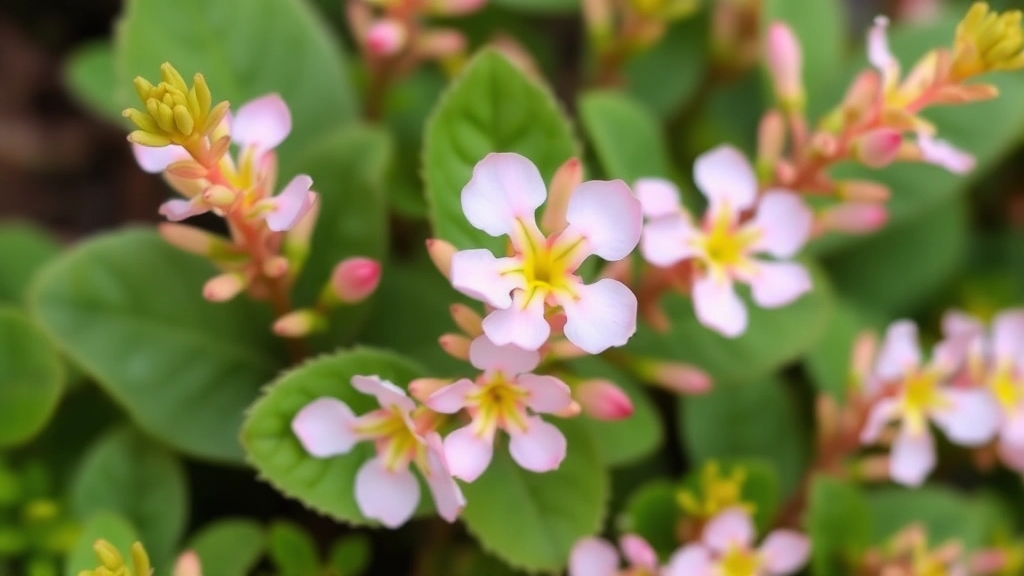Kalanchoe Tomentosa: An Overview
When it comes to the various types of Kalanchoe Tomentosa, there’s a lot to explore. Known for their fuzzy leaves and unique appearance, these succulents are a hit among plant enthusiasts. In this guide, I’ll walk you through some of the different varieties you can find and how they stand out.
From the classic Panda Plant to the rare Chocolate Soldier, each type has its own charm. Whether you’re a seasoned gardener or just starting, understanding these types can help you make the best choice for your collection. Stay tuned as we dive into the world of Kalanchoe Tomentosa!
Overview of Kalanchoe Tomentosa
Are you curious about the charming Kalanchoe Tomentosa?
This delightful succulent, often referred to as the “Panda Plant,” is a popular choice among plant enthusiasts.
What is Kalanchoe Tomentosa?
Kalanchoe Tomentosa is a perennial succulent native to Madagascar, celebrated for its unique foliage and resilience.
With its fuzzy, grey-green leaves adorned with striking brown edges, it adds a touch of whimsy to any indoor or outdoor space.
Key Features
- Leaf Structure: The leaves are thick and fleshy, designed to store water, making it drought-tolerant.
- Growth Habit: Typically grows to about 30 cm in height, making it suitable for various settings.
- Flowers: Occasionally, it produces tubular flowers in shades of yellow or orange, though its leaves are the main attraction.
Kalanchoe Tomentosa is not just a pretty face; it embodies ease of care, making it perfect for both novice and seasoned gardeners alike. If you’re interested in expanding your collection, check out the varieties and care tips for Kalanchoe Tomentosa. Additionally, for comprehensive guidance, refer to this complete Kalanchoe plant care guide.
Common Varieties of Kalanchoe Tomentosa
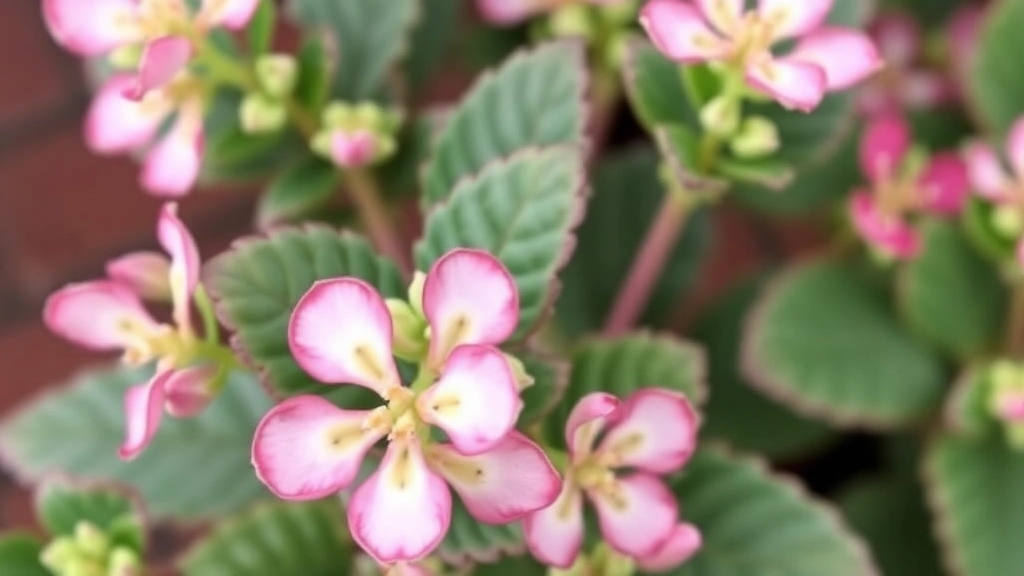
So, you’re curious about the different varieties of Kalanchoe tomentosa? You’re in good company! This charming succulent has some fantastic options to explore.
1. Kalanchoe tomentosa ‘Bear Paw’
This one’s a crowd-pleaser.
- Leaves: They’re thick and fleshy, shaped like little paws, with soft, fuzzy edges.
- Colour: A lovely green, often dusted with a silvery hue.
- Height: Grows up to about 30 cm.
I remember the first time I spotted a ‘Bear Paw’ in a friend’s home. It was hard to resist giving it a gentle squeeze!
2. Kalanchoe tomentosa ‘Chocolate Soldier’
If you’re after something a bit different, this variety might catch your eye.
- Leaves: Darker green with a hint of brownish-purple at the tips.
- Texture: Also fuzzy, but with a more pronounced colour contrast.
- Growth: Tends to be a bit bushier than ‘Bear Paw’.
I love how it adds a unique touch to any succulent collection.
3. Kalanchoe tomentosa ‘Fang’
This variety is a bit of a show-off!
- Leaves: Long and narrow, resembling claws.
- Colour: A vibrant green with striking red edges.
- Height: Can grow taller than others, reaching up to 45 cm.
I once saw a ‘Fang’ at a local plant fair, and it was definitely a head-turner!
4. Kalanchoe tomentosa ‘Silver Dust’
If you fancy a more silvery look, ‘Silver Dust’ is your go-to.
- Leaves: Covered in a fine, white powdery coating.
- Texture: Soft and velvety to the touch.
- Growth Habit: Compact and tidy, perfect for small spaces.
I’ve found that ‘Silver Dust’ really stands out on a windowsill, catching the light beautifully.
Characteristics of Kalanchoe Tomentosa Varieties
When considering the diverse array of Kalanchoe Tomentosa varieties, it’s essential to understand their unique characteristics. This knowledge will help you choose the right type for your collection or garden.
1. Leaf Structure and Texture
Kalanchoe Tomentosa is known for its distinctive leaves, which are typically thick, fleshy, and covered in fine hairs. This gives them a soft, velvety texture.
- Common Leaf Shapes: Varieties may have oval or elongated leaves, often with a rounded tip.
- Colour Variations: While most leaves are green, some varieties exhibit a silvery hue due to their fine hair coverage.
2. Flowering Habits
Kalanchoe Tomentosa produces small, tubular flowers that can vary in colour from yellow to orange or red.
- Blooming Season: Typically, these plants bloom in late winter to early spring.
- Flower Structure: Flowers grow in clusters, making them visually appealing.
3. Growth Habit
These plants generally have a compact growth form, making them suitable for small spaces or as indoor plants.
- Height and Spread: Most varieties reach around 30-45 cm in height and can spread equally wide.
- Growth Rate: Kalanchoe Tomentosa is relatively slow-growing, which can be a plus for those who prefer low-maintenance plants.
4. Resilience
One of the standout characteristics of Kalanchoe Tomentosa is its ability to thrive in various conditions.
Growing Conditions for Kalanchoe Tomentosa
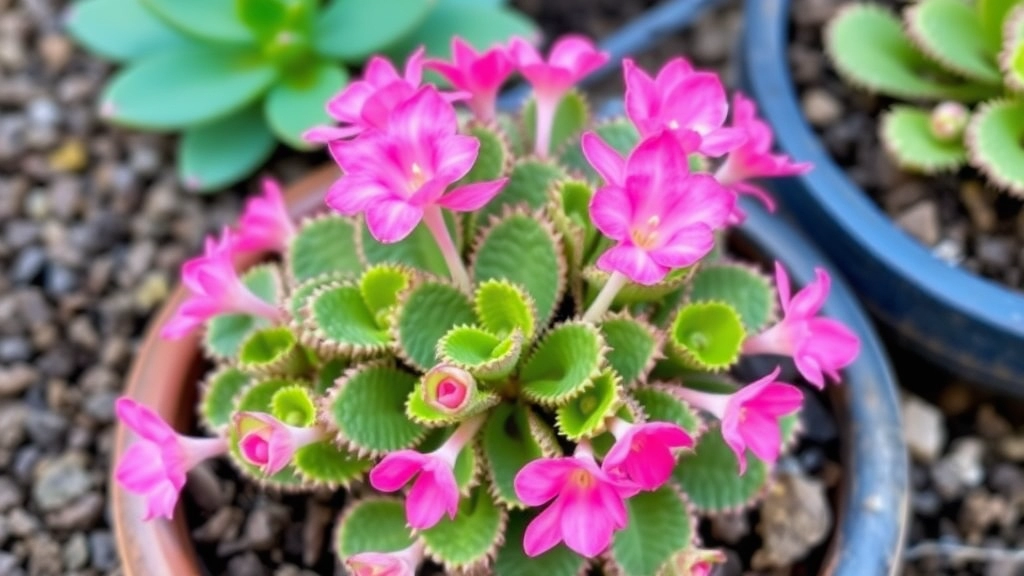
When it comes to successfully cultivating Kalanchoe Tomentosa, understanding the right growing conditions is essential. Many enthusiasts wonder about the optimal environment for this charming succulent.
Light Requirements
Kalanchoe Tomentosa thrives in bright, indirect sunlight.
- Ideal Location: A south or east-facing window works best.
- Avoid Direct Sun: Too much direct sunlight can scorch the leaves.
Temperature Preferences
This succulent prefers a warm environment.
- Optimal Range: 18°C to 24°C (65°F to 75°F) is ideal.
- Cold Sensitivity: Protect from temperatures below 10°C (50°F).
Soil Composition
The right soil mix is crucial for healthy growth.
- Well-Draining Soil: Use a cactus or succulent mix.
- DIY Option: Combine potting soil with sand or perlite for better drainage.
Watering Practices
Understanding the watering needs of Kalanchoe Tomentosa can prevent root rot.
- Frequency: Water when the top inch of soil feels dry.
- Method: Water thoroughly, then allow excess to drain.
Humidity Levels
Kalanchoe Tomentosa prefers low humidity.
- Ideal Humidity: Around 30% to 50% is sufficient.
- Avoid Misting: Excess moisture can lead to fungal issues.
Care Tips for Different Kalanchoe Tomentosa Types
As we delve deeper into the care requirements of Kalanchoe Tomentosa, it’s essential to understand that each variety may have unique needs. Whether you’re a seasoned gardener or a beginner, knowing how to care for your Kalanchoe Tomentosa will ensure it thrives beautifully.
Propagation Methods for Kalanchoe Tomentosa
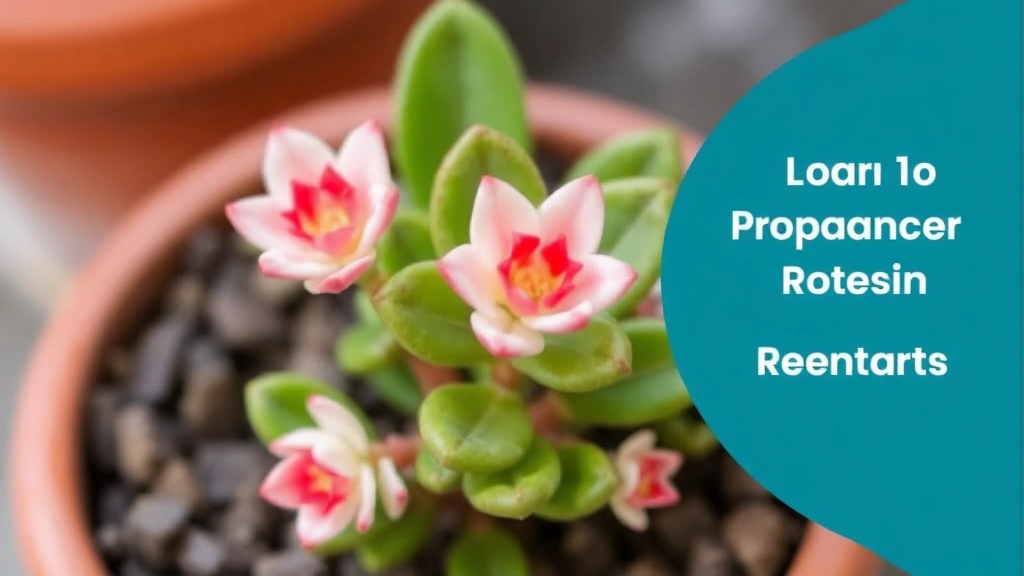
So, you’re keen to expand your Kalanchoe Tomentosa collection? Great choice! Propagation is one of the most rewarding parts of plant care, and it’s easier than you might think.
Why Propagate?
Many folks wonder why they should propagate their plants. Well, here’s the scoop:
- Cost-Effective: Why buy new plants when you can grow your own?
- Gift Ideas: Share the love with friends and family.
- Plant Health: It can help rejuvenate your existing plants.
How to Propagate Kalanchoe Tomentosa
There are a couple of straightforward methods to propagate this lovely succulent. Let’s break it down:
1. Leaf Cuttings
- Choose a Healthy Leaf: Pick a plump, healthy leaf from the parent plant.
- Let It Callous: Leave it on a dry surface for a few days. This helps prevent rot.
- Plant It: Place the leaf on top of well-draining soil, or bury the cut end slightly.
- Water Sparingly: Mist the soil lightly, but don’t soak it.
2. Offsets
- Look for Offsets: These are little baby plants that grow at the base of the parent.
- Gently Remove: Use a clean knife to detach them from the main plant.
- Let Them Callous: Just like with leaf cuttings, let them sit for a few days.
- Plant and Water: Place them in soil and give them a light misting.
Tips for Successful Propagation
- Use Well-Draining Soil: This is key for preventing rot.
- Keep It Warm: A warm, bright spot is ideal for growth.
- Patience is Key: It may take a few weeks for roots to develop.
Common Pests and Diseases
As we explore the fascinating world of Kalanchoe Tomentosa, it’s essential to address a crucial aspect: the common pests and diseases that can affect these charming succulents.
Pests
Kalanchoe Tomentosa can attract a few unwelcome guests. Here are the most common pests to watch out for:
- Mealybugs: These small, white, cottony insects often hide in the leaf joints. They suck the sap, leading to stunted growth.
- Aphids: Tiny and often green or black, aphids can cause curling leaves and reduced vitality.
- Spider Mites: These pests thrive in dry conditions and can create fine webbing on the plant, leading to yellowing leaves.
- Scale Insects: They appear as small, brown bumps on the leaves, robbing the plant of nutrients.
Diseases
While Kalanchoe Tomentosa is relatively hardy, it isn’t immune to diseases. The most common issues include:
- Root Rot: Caused by overwatering, this disease can lead to mushy roots and a wilting plant.
- Leaf Spot: Fungal infections can create dark spots on leaves, often due to high humidity or poor air circulation.
- Powdery Mildew: This white fungal growth can appear on the leaves, especially in damp conditions.
Prevention and Treatment
To keep your Kalanchoe Tomentosa healthy, here are some straightforward prevention and treatment tips:
- Regular Inspection: Check your plants weekly for any signs of pests or diseases.
- Proper Watering: Ensure the soil dries out between waterings to prevent root rot.
- Good Air Circulation: Place plants in well-ventilated areas to reduce humidity-related issues.
- Organic Insecticides: Use neem oil or insecticidal soap to treat infestations, ensuring to follow the guidelines for application.
By staying vigilant and proactive, you can protect your Kalanchoe Tomentosa from these common threats. For more detailed care instructions, check out our Kalanchoe Tomentosa care guide. Additionally, if you notice curling leaves, our guide on causes and solutions for Kalanchoe leaves curling might be helpful.
Decorative Uses of Kalanchoe Tomentosa Varieties
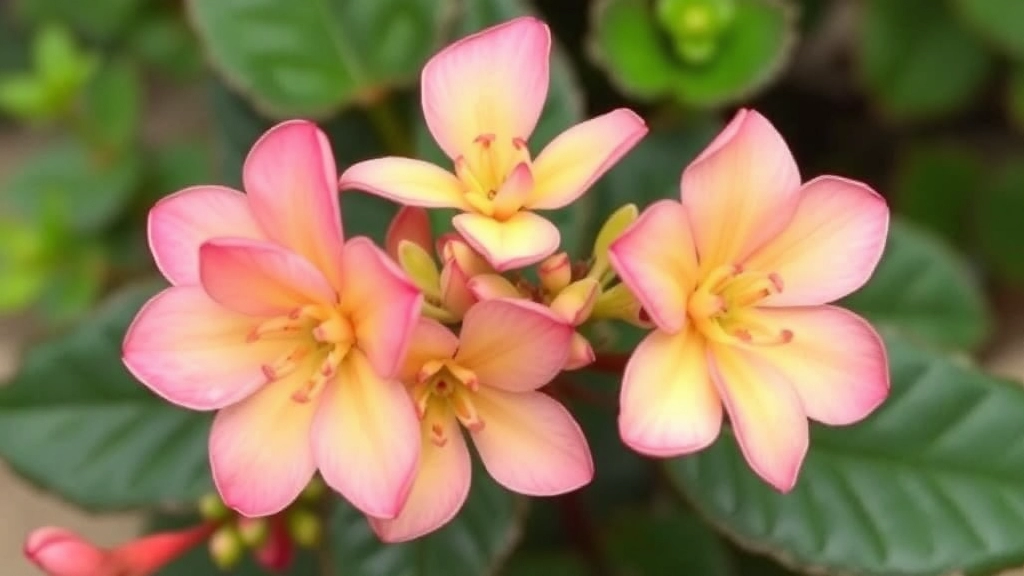
So, you’ve got your Kalanchoe Tomentosa and you’re itching to show it off, right?
These charming succulents are not just easy to care for; they also add a unique flair to your living space.
Here’s how you can incorporate Kalanchoe Tomentosa varieties into your decor:
- Table Centrepieces: Plop a Kalanchoe Tomentosa in a quirky pot and watch it steal the spotlight on your dining table. It’s a conversation starter for sure!
- Windowsills: They thrive in bright light, making them perfect for your kitchen or living room windowsill. Plus, the fuzzy leaves look adorable against the sunlight.
- Hanging Planters: Try a hanging planter for a fun twist. The cascading leaves can create a lush, green waterfall effect that’s simply stunning.
- Terrariums: Pair them with other small succulents in a terrarium. The contrast between the Kalanchoe’s texture and the smooth leaves of others creates a visual delight.
- Office Spaces: A small pot on your desk can brighten up your workspace. It’s low-maintenance and helps to purify the air, making it a win-win!
- Gifts: These plants make fantastic gifts. A Kalanchoe Tomentosa in a decorative pot can bring a smile to anyone’s face.
Personal Touch:
I remember gifting one to a friend who was feeling a bit down. Not only did it lift her spirits, but it also became a lovely part of her home decor.
Incorporating these plants into your decor is not just about aesthetics; it’s about creating a vibe.
As we delve into seasonal care and maintenance, it’s essential to recognize how these factors can significantly impact the health and vibrancy of your Kalanchoe Tomentosa.
### Spring Care
In spring, your Kalanchoe Tomentosa will begin to wake up from its winter dormancy. This is an ideal time for:
– **Repotting**: If your plant has outgrown its pot, consider repotting into a slightly larger container.
– **Fertilising**: Use a balanced, water-soluble fertiliser to promote growth.
– **Watering**: Increase watering frequency as temperatures rise, ensuring the soil dries out between waterings.
### Summer Maintenance
During the summer months, your Kalanchoe will thrive with proper care. Focus on:
– **Light Exposure**: Ensure it receives bright, indirect sunlight. Too much direct sun can scorch the leaves.
– **Humidity Control**: Maintain moderate humidity levels, as excessive moisture can lead to rot.
– **Pest Monitoring**: Keep an eye out for pests like mealybugs and aphids, which can thrive in warm conditions.
### Autumn Preparation
As autumn approaches, prepare your Kalanchoe for the cooler months:
– **Reduced Watering**: Gradually decrease watering frequency as the plant’s growth slows down.
– **Temperature Awareness**: Ensure the plant is kept in a warmer environment, ideally above 10°C (50°F).
– **Pruning**: Trim any dead or wilted leaves to promote airflow and health.
### Winter Care
Winter can be a challenging time for Kalanchoe Tomentosa. Here’s how to keep it thriving:
– **Light Requirements**: Position your plant near a sunny window to maximise light exposure.
– **Water Sparingly**: Water only when the soil is completely dry. Overwatering can lead to root rot.
– **Temperature Management**: Protect from cold drafts and maintain a stable temperature.
FAQs on Types of Kalanchoe Tomentosa
What are some common varieties of Kalanchoe Tomentosa?
There are several popular varieties of Kalanchoe Tomentosa, including ‘Bear Paw’, ‘Chocolate Soldier’, ‘Fang’, and ‘Silver Dust’. Each has unique characteristics in terms of leaf shape, color, and growth habits.
What is unique about Kalanchoe Tomentosa ‘Bear Paw’?
‘Bear Paw’ is known for its thick, fleshy leaves that resemble little paws with soft, fuzzy edges. It typically grows up to about 30 cm and has a lovely green color often dusted with a silvery hue.
How does ‘Chocolate Soldier’ differ from other varieties?
‘Chocolate Soldier’ features darker green leaves with a hint of brownish-purple at the tips. It has a more pronounced color contrast and tends to be bushier compared to other varieties.
What makes ‘Fang’ a standout variety?
‘Fang’ is notable for its long, narrow leaves that resemble claws. The vibrant green leaves with striking red edges can grow taller than other varieties, reaching up to 45 cm.
Why is ‘Silver Dust’ a popular choice?
‘Silver Dust’ is favored for its silvery look, with leaves covered in a fine, white powdery coating. Its soft, velvety texture and compact growth habit make it perfect for small spaces.
FAQs on Growing Conditions for Kalanchoe Tomentosa
What kind of light does Kalanchoe Tomentosa need?
Kalanchoe Tomentosa thrives in bright, indirect sunlight. A south or east-facing window is ideal, but avoid too much direct sunlight as it can scorch the leaves.
What is the optimal temperature range for Kalanchoe Tomentosa?
This succulent prefers a warm environment, ideally between 18°C to 24°C (65°F to 75°F). Protect it from temperatures below 10°C (50°F).
What type of soil is best for Kalanchoe Tomentosa?
Well-draining soil is crucial for healthy growth. Use a cactus or succulent mix, or combine potting soil with sand or perlite for better drainage.
How often should I water Kalanchoe Tomentosa?
Water when the top inch of soil feels dry. Water thoroughly, then allow excess water to drain. Avoid overwatering to prevent root rot.
Does Kalanchoe Tomentosa need high humidity?
No, Kalanchoe Tomentosa prefers low humidity levels around 30% to 50%. Avoid misting the plant as excess moisture can lead to fungal issues.
FAQs on Propagation Methods for Kalanchoe Tomentosa
Why should I propagate Kalanchoe Tomentosa?
Propagation is cost-effective, allows you to share plants with friends and family, and can help rejuvenate your existing plants.
What are the methods to propagate Kalanchoe Tomentosa?
You can propagate Kalanchoe Tomentosa through leaf cuttings or offsets. Both methods are straightforward and rewarding.
How do I propagate Kalanchoe Tomentosa using leaf cuttings?
Choose a healthy leaf, let it callous for a few days, plant it in well-draining soil, and water sparingly. Mist the soil lightly but don’t soak it.
How do I propagate Kalanchoe Tomentosa using offsets?
Look for offsets at the base of the parent plant, gently remove them with a clean knife, let them callous for a few days, then plant and water them lightly.
What tips can help ensure successful propagation?
Use well-draining soil, keep the propagated plants in a warm, bright spot, and be patient as it may take a few weeks for roots to develop.
FAQs on Decorative Uses of Kalanchoe Tomentosa Varieties
How can I use Kalanchoe Tomentosa in my home decor?
Kalanchoe Tomentosa can be used as table centerpieces, on windowsills, in hanging planters, terrariums, office spaces, and as gifts. Their unique appearance adds a charming flair to any living space.
Why are Kalanchoe Tomentosa varieties suitable for windowsills?
They thrive in bright light and their fuzzy leaves look adorable against the sunlight, making them perfect for kitchen or living room windowsills.
Can Kalanchoe Tomentosa be used in terrariums?
Yes, they pair well with other small succulents in terrariums. The contrast between Kalanchoe’s texture and the smooth leaves of other plants creates a visual delight.
Are Kalanchoe Tomentosa plants good for office spaces?
Absolutely. A small pot on your desk can brighten up your workspace. They are low-maintenance and help purify the air, making them a great addition to any office.
Can Kalanchoe Tomentosa make good gifts?
Yes, these plants make fantastic gifts. A Kalanchoe Tomentosa in a decorative pot can bring a smile to anyone’s face and add a lovely touch to their home decor.
References
-
Kalanchoe tomentosa (Panda Plant, Chocolate Soldier)
-
Kalanchoe tomentosa
-
Kalanchoe Tomentosa: A Detailed Guide
